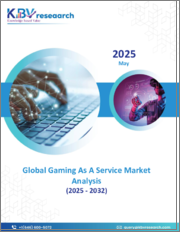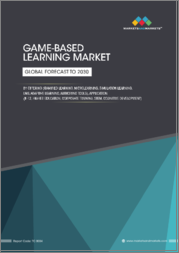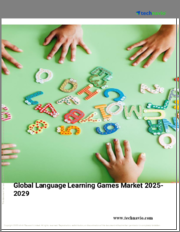
|
시장보고서
상품코드
1505176
세계의 게임 기반 학습 시장(2024-2031년)Global Game-Based Learning Market 2024-2031 |
||||||
세계 게임 기반 학습 시장 규모는 2024-2031년의 예측 기간 동안 연평균 21.4%의 높은 성장률을 나타낼 것으로 예상됩니다. 게임 기반 학습은 학습자의 동기를 부여하고 학습 과정을 보다 재미있고 효과적으로 만들기 위해 매력적인 게임이나 시뮬레이션을 통해 교육 컨텐츠를 제공하는 프레임워크입니다. 핵심 지식, 인터랙티브한 경험, 포인트, 배지, 리더보드, 스토리 등 동기부여 요소가 포함됩니다.
시장 역학
매력적인 학습에 대한 수요 증가
전통적인 학습 방법은 때때로 건조하고 단조로운 경우가 많습니다. 게임 기반 학습은 학습 과정에 재미와 상호작용을 불어넣어 학습자의 참여와 동기 부여를 향상시킬 수 있습니다. 특히 인터랙티브한 디지털 경험에 익숙한 젊은 세대에게 특히 효과적입니다.
기술의 발전
가상현실(VR)과 증강현실(AR)과 같은 기술의 등장은 게임 기반 학습에 혁명을 불러일으키고 있습니다. 이러한 몰입형 경험은 현실적인 시뮬레이션과 시나리오를 만들어 학습 과정을 더욱 강화할 수 있으며, 코로나19 사태는 게임 기반 학습 시장에 긍정적인 영향을 미쳐 다양한 분야에서의 성장과 채택을 가속화했습니다. 학교, 대학 및 교육 센터의 폐쇄가 확산되면서 온라인 및 원격 학습 솔루션으로의 전환이 두드러지게 나타났고, 게임 기반 학습 플랫폼을 포함한 디지털 교육 도구에 대한 수요가 증가했습니다.
시장 세분화
- 유형별로는 위치기반 게임, AR/VR 게임, AI 기반 게임, 언어 학습, 스킬 기반 학습, 시뮬레이션을 포함한 기타로 구분됩니다.
- 용도별로는 비판적 사고-문제해결, 교육-역량개발, 평가로 구분됩니다.
- 최종 사용자별로는 IT 및 통신, 소매, 소비자, 제조, 정부, 교육, 헬스케어, 생명과학을 포함한 기타로 구분됩니다.
- 플랫폼별로는 온라인과 오프라인으로 시장이 세분화됩니다.
위치정보게임이 가장 큰 부문와 전망
위치기반 게임(LBG) 하위 부문은 참여도 증가, 몰입도, 능동적 학습, 협업, 실세계 적용, 기술 발전, 접근성 등으로 인해 시장에서 가장 큰 점유율을 차지할 것으로 예상되며, LBG는 현실 세계를 게임판으로 활용하고 학습을 더욱 인상적이고 매력적으로 만듭니다, LBG는 문제 해결, 비판적 사고, 팀워크 기술을 장려하며, 학습을 더욱 인상적이고 매력적으로 만듭니다. 모바일 기술, GPS, 증강현실(AR)과 같은 기술의 발전은 학습 경험을 더욱 풍부하게 합니다. 또한, 스마트폰 및 태블릿을 통해 LBG는 더욱 친숙해지고 있습니다. 이러한 기술은 현실 세계의 장소와 물리적 환경을 교육용 게임에 통합하여 몰입감 있고 인터랙티브한 학습 경험을 창출할 수 있게 해줍니다.
온라인 하위 부문이 큰 시장 점유율을 차지합니다.
온라인 하위 부문은 접근성, 확장성, 비용 효율성 및 확고한 입지를 바탕으로 현재 게임 기반 학습에서 큰 시장 점유율을 차지하고 있습니다. 온라인 게임 기반 학습 솔루션은 웹 브라우저, 모바일 앱, 학습 관리 시스템을 통해 쉽게 접근할 수 있기 때문에 비용 효율적이고 많은 학습자가 이용할 수 있습니다. 시장은 이미 성숙하고 정착되어 있으며, 다양한 학습 수요를 충족하는 수많은 솔루션이 있습니다. 게임 메커니즘, 스토리텔링, 소셜 학습 요소, 마이크로러닝 및 게임화 과정의 발전은 온라인 학습의 과제를 해결하고 있습니다. 가상현실과 인공지능과 같은 미래 기술 발전은 온라인 게임 기반 학습 경험을 더욱 향상시킬 수 있습니다.
지역별 전망
세계 게임 기반 학습 시장은 북미(미국, 캐나다), 유럽(영국, 이탈리아, 스페인, 독일, 프랑스, 기타 유럽), 아시아태평양(인도, 중국, 일본, 한국, 기타 아시아태평양), 기타 지역(중동 및 아프리카, 중남미) 등 지역별로 세분화되어 있습니다. 세분화되어 있습니다.
북미가 주요 시장 점유율을 차지합니다.
북미 게임 기반 학습 시장은 혁신에 대한 관심, 에듀테크에 대한 투자, 기술의 조기 도입, 개별화 학습에 대한 집중 등의 요인에 의해 주도되고 있습니다. 북미의 탄탄한 기술 생태계, 빠른 기술 도입, 다양한 학습자들로 인해 북미의 학습은 매력적인 학습 환경으로 자리 잡았습니다. 게임 기반 학습은 흥미롭고, 상호작용적이며, 적응력 있는 학습 경험에 대한 수요 증가에 부응하고 있습니다. 또한, 빠르게 변화하는 고용 시장과 숙련되고 적응력 있는 인재에 대한 수요에도 대응하고 있습니다. 게임 기반 학습은 비판적 사고, 문제 해결, 소프트 스킬과 같은 기술을 다룰 수 있어 보다 매력적인 교육 방법을 제공합니다. 정부 이니셔티브, 강력한 자금 조달 환경, 높은 가처분 소득이 이 시장을 더욱 뒷받침하고 있습니다. 기술에 능통한 인구, 지원적인 정부 정책, 탄탄한 자금 조달 환경은 게임 기반 학습 시장의 리더로서의 지위를 더욱 공고히 하고 있습니다.
최근 동향
- 2024년 2월, Kahoot는 모바일 앱과 온라인 플랫폼을 인도네시아어로 확장할 계획을 발표했습니다. 이 계획은 신흥 시장에 진출하는 동시에 이 지역의 모든 연령대의 사람들에게 재미있고 풍부한 교육 경험을 제공하는 것을 목표로 하고 있습니다. 지난 1년간 1,500만 명 이상이 게임 플레이에 참여하면서 Kahoot! 는 인도네시아에서 가장 선호되는 인터랙티브 학습 플랫폼으로 자리매김하고 있습니다.
- Duolingo는 2023년 3월, 인도의 3-8세 어린이들에게 영어를 재미있게 가르치는 무료 앱 'Duolingo ABC'를 출시했습니다. 이 앱에는 파닉스, 알파벳, 시력 단어를 가르치는 700개 이상의 한 입 크기의 모듈이 포함되어 있으며, 광고와 인앱 구매가 없는 어린이 친화적인 인터페이스로 구축되어 있습니다.
목차
제1장 보고서 개요
- 산업 현황 분석과 성장 가능성 전망
- 조사 방법과 툴
- 시장 내역
- 부문별
- 지역별
제2장 시장 개요와 인사이트
- 조사 범위
- 애널리스트 인사이트와 현재 시장 동향
- 주요 산업 동향
- 시장 추천 사항
- 결론
제3장 경쟁 구도
- 주요 기업 분석
- Amazon Web Service, Inc.
- 개요
- 재무 분석
- SWOT 분석
- 최근 동향
- Duolingo, Inc.
- Google LLC
- 주요 전략 분석
제4장 시장 세분화
- 세계의 게임 기반 러닝 시장 : 유형별
- 위치 정보 게임
- AR/VR 게임
- AI 기반 게임
- 언어학습
- 기타(스킬 기반 러닝, 시뮬레이션)
- 세계의 게임 기반 러닝 시장 : 최종사용자별
- IT 및 통신
- 소매
- 소비자
- 제조
- 기타(정부, 교육, 헬스케어, 생명과학)
- 세계의 게임 기반 러닝 시장 : 용도별
- 비판적 사고 및 문제 해결
- 트레이닝 및 능력개발
- 평가
- 세계의 게임 기반 러닝 시장 : 플랫폼별
- 온라인
- 오프라인
제5장 지역 분석
- 북미
- 미국
- 캐나다
- 유럽
- 영국
- 독일
- 이탈리아
- 스페인
- 프랑스
- 기타 유럽
- 아시아태평양
- 중국
- 인도
- 일본
- 한국
- 기타 아시아태평양
- 기타 지역
- 라틴아메리카
- 중동 및 아프리카
제6장 기업 개요
- Age of Learning, Inc.
- Badgeville(CallidusCloud)
- Breakaway Games
- Bunchball(BI WORLDWIDE)
- Epic Games
- Filament Games
- Fundamentor(Paratus Knowledge Ventures Pvt Ltd)
- Gametize Pte. Ltd.
- Kahoot!ASA
- Lumos Labs
- Mojang Studios
- Quizizz, Inc.
- Recurrence Inc.
- Six Waves Inc.
- Tangible Play, Inc.
- Toolwire Inc.
Game-Based Learning Market Size, Share & Trends Analysis Report by Type (Location-Based Games, AR/VR Games, and Others), by Application (Critical Thinking & Problem-Solving, Training & Development, and Evaluation), by Platform (Online, and Offline), End-User (IT & Telecom, Retail, Consumer, Manufacturing, and Others) Forecast Period (2024-2031)
Game-based learning market is anticipated to grow at a significant CAGR of 21.4% during the forecast period (2024-2031). Game-based Learning is a framework in which educational content is presented through engaging games and simulations, aiming to motivate learners and make the learning process more enjoyable and effective. Its aspects include core knowledge, interactive experiences, and motivational elements like points, badges, leaderboards, and storylines.
Market Dynamics
Increased Demand for Engaging Learning
Traditional learning methods can sometimes be dry and monotonous. Game-based learning injects fun and interactivity into the process, leading to higher engagement and motivation among learners. This is particularly effective for younger generations who are accustomed to interactive digital experiences.
Increased Technological Advancements
The rise of technologies such as virtual reality (VR) and augmented reality (AR) is revolutionizing game-based learning. These immersive experiences can create realistic simulations and scenarios, further enhancing the learning process. The COVID-19 pandemic had a positive impact on the game-based learning market, accelerating its growth and adoption across various sectors. With the widespread closure of schools, universities, and training centers, there was a significant shift towards online and remote learning solutions, which led to an increased demand for digital educational tools, including game-based learning platforms.
Market Segmentation
- Based on type, the market is segmented into location-based games, AR/VR games, and others including AI-based games, language learning, skill-based learning, and simulation.
- Based on application, the market is segmented into critical thinking & problem-solving, training & development, and evaluation.
- Based on end-users, the market is segmented into IT & telecom, retail, consumer, manufacturing, and others including government, education, healthcare & life sciences.
- Based on the platform, the market is augmented into online, and offline.
Location-based Game is Projected to Emerge as the Largest Segment
Location-based games (LBG) sub-segment is expected to hold the largest share of the market due to their increased engagement, immersive nature, active learning, collaboration, real-world application, technological advancements, and accessibility. LBGs leverage the real world as the game board, making learning more memorable and engaging. They encourage problem-solving, critical thinking, and teamwork skills. Technological advancements like mobile technology, GPS, and augmented reality (AR) further enrich the learning experience. LBGs are also becoming more accessible, with smartphones and tablets making them more accessible. These technologies enable the integration of real-world locations and physical environments into educational games, creating immersive and interactive learning experiences.
Online Sub-segment to Hold a Considerable Market Share
The online sub-segment currently holds a significant market share in game-based learning due to its accessibility, scalability, cost-effectiveness, and established presence. Online game-based learning solutions are easily accessible through web browsers, mobile apps, and learning management systems, making them cost-effective and accessible to many learners. The market is mature and well-established, with a vast array of solutions catering to diverse learning needs. Advancements in-game mechanics, storytelling, social learning elements, and microlearning and gamified courses are addressing challenges in online learning. Future advancements in technology, such as virtual reality and artificial intelligence, could further enhance the online game-based learning experience.
Regional Outlook
The global game-based learning market is further segmented based on geography including North America (the US, and Canada), Europe (UK, Italy, Spain, Germany, France, and the Rest of Europe), Asia-Pacific (India, China, Japan, South Korea, and Rest of Asia-Pacific), and the Rest of the World (the Middle East & Africa, and Latin America).
North America Holds Major Market Share
North America's game-based learning market is dominated by factors such as a strong emphasis on innovation, investment in Edtech, early adoption of technology, and focus on personalized learning. The country's robust tech ecosystem, early adoption of technology, and diverse learners make it an attractive option for learning. Game-based learning addresses the growing demand for engaging, interactive, and adaptable learning experiences. It also caters to the rapidly changing job market, requiring skilled and adaptable workforces. Game-based learning can address skills like critical thinking, problem-solving, and soft skills, and offers a more engaging training method. Government initiatives, a strong funding environment, and high disposable income further support the market. The country's tech-savvy population, supportive government policies, and robust funding environment further solidify its position as a leader in the game-based learning market.
Market Players Outlook
The major companies serving the global game-based learning market include Amazon Web Services, Inc., Google LLC, Duolingo, Inc., and Epic Games, among others. The market players are increasingly focusing on business expansion and product development by applying strategies such as collaborations, mergers, and acquisitions to stay competitive in the market.
Recent Developments-
- In February 2024, Kahoot! announced plans to broaden its mobile apps and online platform to include the Indonesian language. This initiative seeks to provide enjoyable and enriching educational experiences to individuals of all ages in the area while also reaching out to emerging markets. With more than 15 million participants engaging in gameplay over the past year, Kahoot! has solidified its position as a favored platform for interactive learning in Indonesia.
- In March 2023, Duolingo launched its free-to-use app, Duolingo ABC, to teach English to kids aged 3-8 years in India in a fun and gamified way. The app includes more than 700 bite-sized modules teaching phonics, alphabet, and sight words and is built on a child-friendly interface with no ads and in-app purchases.
Table of Contents
1. Report Summary
- Current Industry Analysis and Growth Potential Outlook
- 1.1. Research Methods and Tools
- 1.2. Market Breakdown
- 1.2.1. By Segments
- 1.2.2. By Region
2. Market Overview and Insights
- 2.1. Scope of the Report
- 2.2. Analyst Insight & Current Market Trends
- 2.2.1. Key Industry Trends
- 2.2.2. Market Recommendations
- 2.2.3. Conclusion
3. Competitive Landscape
- 3.1. Key Company Analysis
- 3.2. Amazon Web Service, Inc.
- 3.2.1. Overview
- 3.2.2. Financial Analysis
- 3.2.3. SWOT Analysis
- 3.2.4. Recent Developments
- 3.3. Duolingo, Inc.
- 3.3.1. Overview
- 3.3.2. Financial Analysis
- 3.3.3. SWOT Analysis
- 3.3.4. Recent Developments
- 3.4. Google LLC
- 3.4.1. Overview
- 3.4.2. Financial Analysis
- 3.4.3. SWOT Analysis
- 3.4.4. Recent Developments
- 3.5. Key Strategy Analysis
4. Market Segmentation
- 4.1. Global Game-based Learning Market by Type
- 4.1.1. Location-Based Games
- 4.1.2. AR/VR Games
- 4.1.3. AI-Based Games
- 4.1.4. Language Learning
- 4.1.5. Others (Skill-Based Learning, Simulation)
- 4.2. Global Game-based Learning Market by End-user
- 4.2.1. IT & Telecom
- 4.2.2. Retail
- 4.2.3. Consumer
- 4.2.4. Manufacturing
- 4.2.5. Others (Government, Education, Healthcare & Life Sciences)
- 4.3. Global Game-based Learning Market by Application
- 4.3.1. Critical Thinking & Problem-Solving
- 4.3.2. Training & Development
- 4.3.3. Evaluation
- 4.4 Global Game-based Learning Market by Platform
- 4.4.1. Online
- 4.4.2. Offline
5. Regional Analysis
- 5.1. North America
- 5.1.1. United States
- 5.1.2. Canada
- 5.2. Europe
- 5.2.1. UK
- 5.2.2. Germany
- 5.2.3. Italy
- 5.2.4. Spain
- 5.2.5. France
- 5.2.6. Rest of Europe
- 5.3. Asia-Pacific
- 5.3.1. China
- 5.3.2. India
- 5.3.3. Japan
- 5.3.4. South Korea
- 5.3.5. Rest of Asia-Pacific
- 5.4. Rest of the World
- 5.4.1. Latin America
- 5.4.2. Middle East & Africa
6. Company Profiles
- 6.1. Age of Learning, Inc.
- 6.2. Badgeville (CallidusCloud)
- 6.3. Breakaway Games
- 6.4. Bunchball (BI WORLDWIDE)
- 6.5. Epic Games
- 6.6. Filament Games
- 6.7. Fundamentor (Paratus Knowledge Ventures Pvt Ltd)
- 6.8. Gametize Pte. Ltd.
- 6.9. Kahoot! ASA
- 6.10. Lumos Labs
- 6.11. Mojang Studios
- 6.12. Quizizz, Inc.
- 6.13. Recurrence Inc.
- 6.14. Six Waves Inc.
- 6.15. Tangible Play, Inc.
- 6.16. Toolwire Inc.



















